Wireless Network and Security - Assignment
VerifiedAdded on 2021/06/14
|8
|2350
|16
AI Summary
Contribute Materials
Your contribution can guide someone’s learning journey. Share your
documents today.
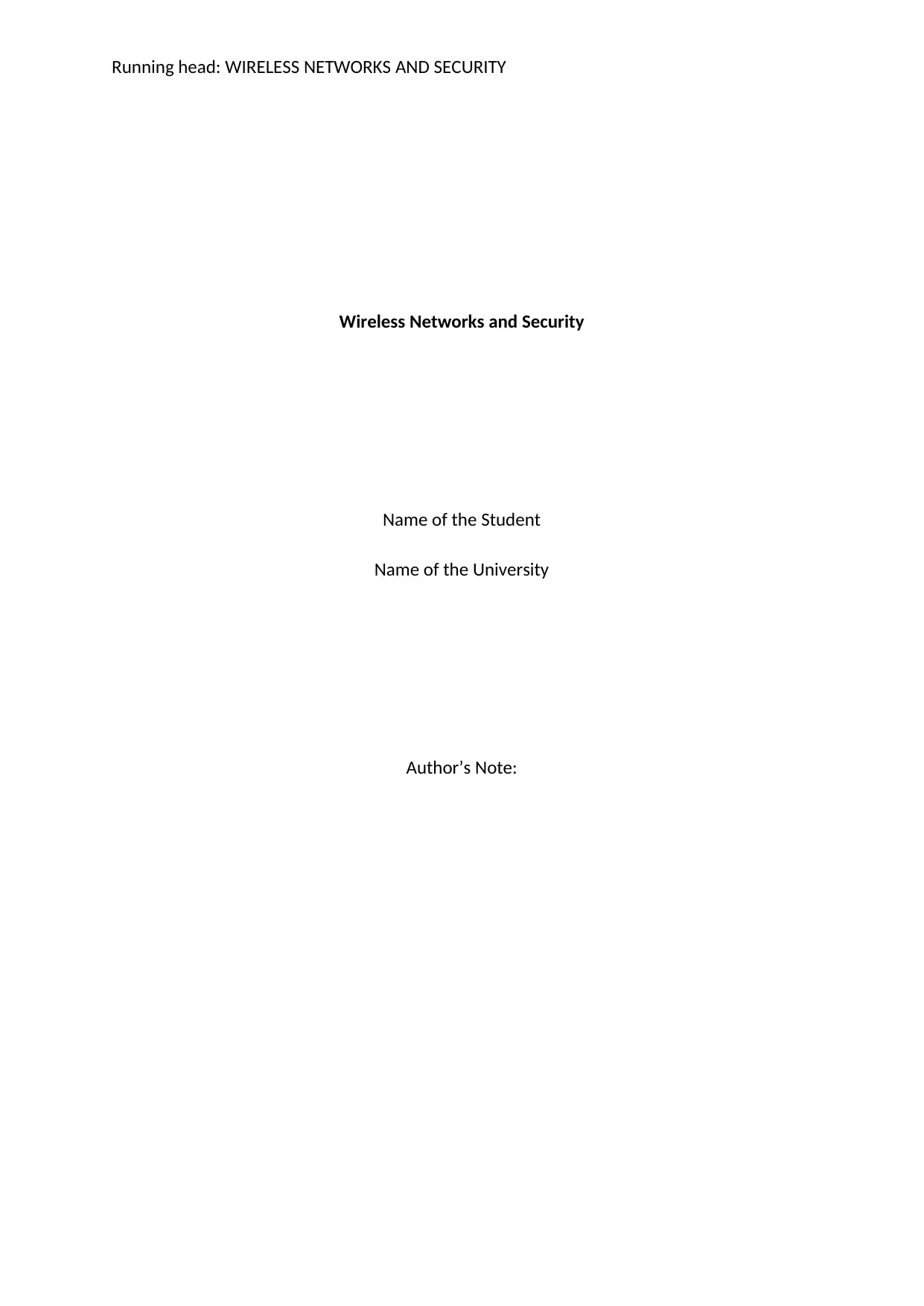
Running head: WIRELESS NETWORKS AND SECURITY
Wireless Networks and Security
Name of the Student
Name of the University
Author’s Note:
Wireless Networks and Security
Name of the Student
Name of the University
Author’s Note:
Secure Best Marks with AI Grader
Need help grading? Try our AI Grader for instant feedback on your assignments.
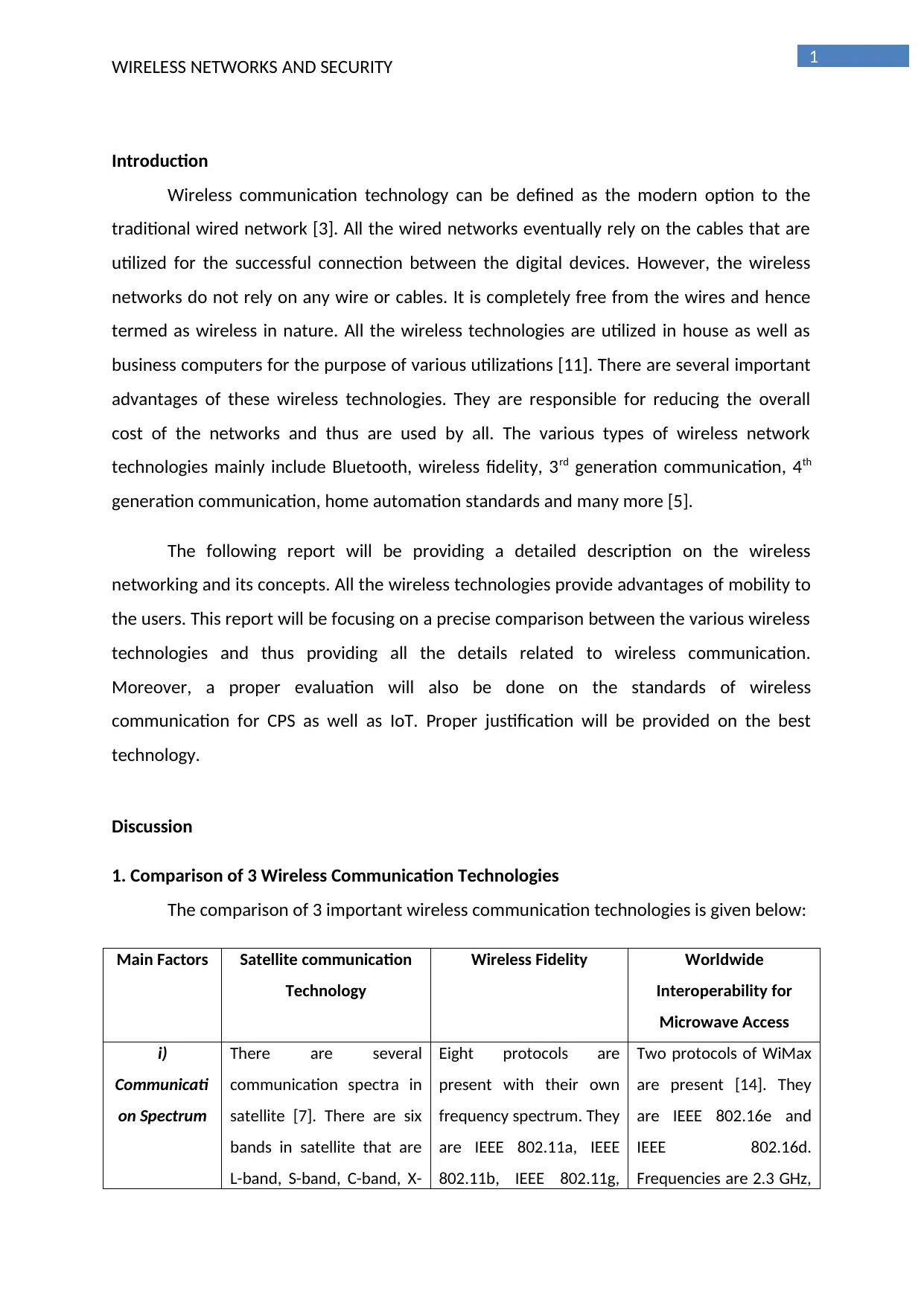
1
WIRELESS NETWORKS AND SECURITY
Introduction
Wireless communication technology can be defined as the modern option to the
traditional wired network [3]. All the wired networks eventually rely on the cables that are
utilized for the successful connection between the digital devices. However, the wireless
networks do not rely on any wire or cables. It is completely free from the wires and hence
termed as wireless in nature. All the wireless technologies are utilized in house as well as
business computers for the purpose of various utilizations [11]. There are several important
advantages of these wireless technologies. They are responsible for reducing the overall
cost of the networks and thus are used by all. The various types of wireless network
technologies mainly include Bluetooth, wireless fidelity, 3rd generation communication, 4th
generation communication, home automation standards and many more [5].
The following report will be providing a detailed description on the wireless
networking and its concepts. All the wireless technologies provide advantages of mobility to
the users. This report will be focusing on a precise comparison between the various wireless
technologies and thus providing all the details related to wireless communication.
Moreover, a proper evaluation will also be done on the standards of wireless
communication for CPS as well as IoT. Proper justification will be provided on the best
technology.
Discussion
1. Comparison of 3 Wireless Communication Technologies
The comparison of 3 important wireless communication technologies is given below:
Main Factors Satellite communication
Technology
Wireless Fidelity Worldwide
Interoperability for
Microwave Access
i)
Communicati
on Spectrum
There are several
communication spectra in
satellite [7]. There are six
bands in satellite that are
L-band, S-band, C-band, X-
Eight protocols are
present with their own
frequency spectrum. They
are IEEE 802.11a, IEEE
802.11b, IEEE 802.11g,
Two protocols of WiMax
are present [14]. They
are IEEE 802.16e and
IEEE 802.16d.
Frequencies are 2.3 GHz,
WIRELESS NETWORKS AND SECURITY
Introduction
Wireless communication technology can be defined as the modern option to the
traditional wired network [3]. All the wired networks eventually rely on the cables that are
utilized for the successful connection between the digital devices. However, the wireless
networks do not rely on any wire or cables. It is completely free from the wires and hence
termed as wireless in nature. All the wireless technologies are utilized in house as well as
business computers for the purpose of various utilizations [11]. There are several important
advantages of these wireless technologies. They are responsible for reducing the overall
cost of the networks and thus are used by all. The various types of wireless network
technologies mainly include Bluetooth, wireless fidelity, 3rd generation communication, 4th
generation communication, home automation standards and many more [5].
The following report will be providing a detailed description on the wireless
networking and its concepts. All the wireless technologies provide advantages of mobility to
the users. This report will be focusing on a precise comparison between the various wireless
technologies and thus providing all the details related to wireless communication.
Moreover, a proper evaluation will also be done on the standards of wireless
communication for CPS as well as IoT. Proper justification will be provided on the best
technology.
Discussion
1. Comparison of 3 Wireless Communication Technologies
The comparison of 3 important wireless communication technologies is given below:
Main Factors Satellite communication
Technology
Wireless Fidelity Worldwide
Interoperability for
Microwave Access
i)
Communicati
on Spectrum
There are several
communication spectra in
satellite [7]. There are six
bands in satellite that are
L-band, S-band, C-band, X-
Eight protocols are
present with their own
frequency spectrum. They
are IEEE 802.11a, IEEE
802.11b, IEEE 802.11g,
Two protocols of WiMax
are present [14]. They
are IEEE 802.16e and
IEEE 802.16d.
Frequencies are 2.3 GHz,
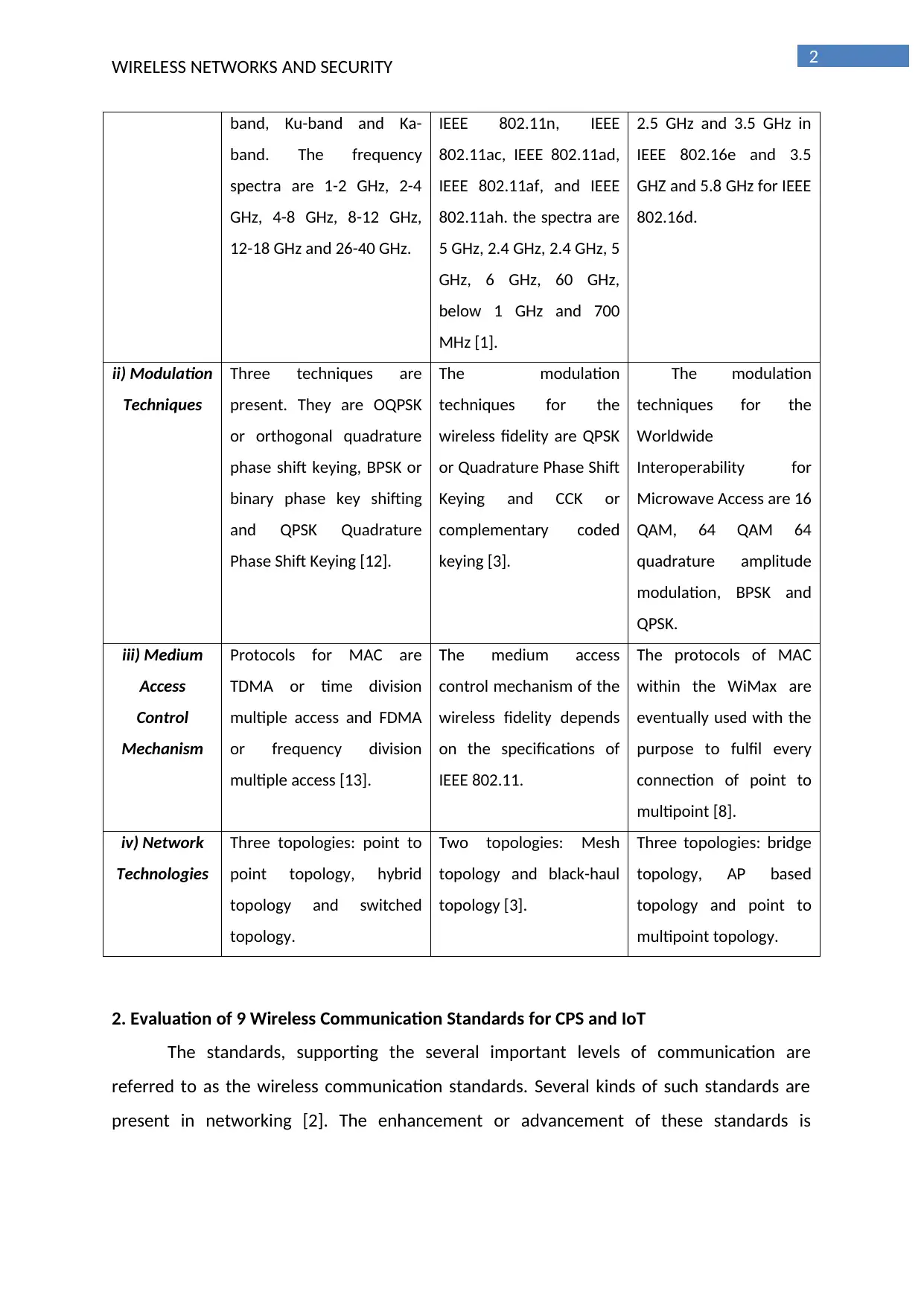
2
WIRELESS NETWORKS AND SECURITY
band, Ku-band and Ka-
band. The frequency
spectra are 1-2 GHz, 2-4
GHz, 4-8 GHz, 8-12 GHz,
12-18 GHz and 26-40 GHz.
IEEE 802.11n, IEEE
802.11ac, IEEE 802.11ad,
IEEE 802.11af, and IEEE
802.11ah. the spectra are
5 GHz, 2.4 GHz, 2.4 GHz, 5
GHz, 6 GHz, 60 GHz,
below 1 GHz and 700
MHz [1].
2.5 GHz and 3.5 GHz in
IEEE 802.16e and 3.5
GHZ and 5.8 GHz for IEEE
802.16d.
ii) Modulation
Techniques
Three techniques are
present. They are OQPSK
or orthogonal quadrature
phase shift keying, BPSK or
binary phase key shifting
and QPSK Quadrature
Phase Shift Keying [12].
The modulation
techniques for the
wireless fidelity are QPSK
or Quadrature Phase Shift
Keying and CCK or
complementary coded
keying [3].
The modulation
techniques for the
Worldwide
Interoperability for
Microwave Access are 16
QAM, 64 QAM 64
quadrature amplitude
modulation, BPSK and
QPSK.
iii) Medium
Access
Control
Mechanism
Protocols for MAC are
TDMA or time division
multiple access and FDMA
or frequency division
multiple access [13].
The medium access
control mechanism of the
wireless fidelity depends
on the specifications of
IEEE 802.11.
The protocols of MAC
within the WiMax are
eventually used with the
purpose to fulfil every
connection of point to
multipoint [8].
iv) Network
Technologies
Three topologies: point to
point topology, hybrid
topology and switched
topology.
Two topologies: Mesh
topology and black-haul
topology [3].
Three topologies: bridge
topology, AP based
topology and point to
multipoint topology.
2. Evaluation of 9 Wireless Communication Standards for CPS and IoT
The standards, supporting the several important levels of communication are
referred to as the wireless communication standards. Several kinds of such standards are
present in networking [2]. The enhancement or advancement of these standards is
WIRELESS NETWORKS AND SECURITY
band, Ku-band and Ka-
band. The frequency
spectra are 1-2 GHz, 2-4
GHz, 4-8 GHz, 8-12 GHz,
12-18 GHz and 26-40 GHz.
IEEE 802.11n, IEEE
802.11ac, IEEE 802.11ad,
IEEE 802.11af, and IEEE
802.11ah. the spectra are
5 GHz, 2.4 GHz, 2.4 GHz, 5
GHz, 6 GHz, 60 GHz,
below 1 GHz and 700
MHz [1].
2.5 GHz and 3.5 GHz in
IEEE 802.16e and 3.5
GHZ and 5.8 GHz for IEEE
802.16d.
ii) Modulation
Techniques
Three techniques are
present. They are OQPSK
or orthogonal quadrature
phase shift keying, BPSK or
binary phase key shifting
and QPSK Quadrature
Phase Shift Keying [12].
The modulation
techniques for the
wireless fidelity are QPSK
or Quadrature Phase Shift
Keying and CCK or
complementary coded
keying [3].
The modulation
techniques for the
Worldwide
Interoperability for
Microwave Access are 16
QAM, 64 QAM 64
quadrature amplitude
modulation, BPSK and
QPSK.
iii) Medium
Access
Control
Mechanism
Protocols for MAC are
TDMA or time division
multiple access and FDMA
or frequency division
multiple access [13].
The medium access
control mechanism of the
wireless fidelity depends
on the specifications of
IEEE 802.11.
The protocols of MAC
within the WiMax are
eventually used with the
purpose to fulfil every
connection of point to
multipoint [8].
iv) Network
Technologies
Three topologies: point to
point topology, hybrid
topology and switched
topology.
Two topologies: Mesh
topology and black-haul
topology [3].
Three topologies: bridge
topology, AP based
topology and point to
multipoint topology.
2. Evaluation of 9 Wireless Communication Standards for CPS and IoT
The standards, supporting the several important levels of communication are
referred to as the wireless communication standards. Several kinds of such standards are
present in networking [2]. The enhancement or advancement of these standards is
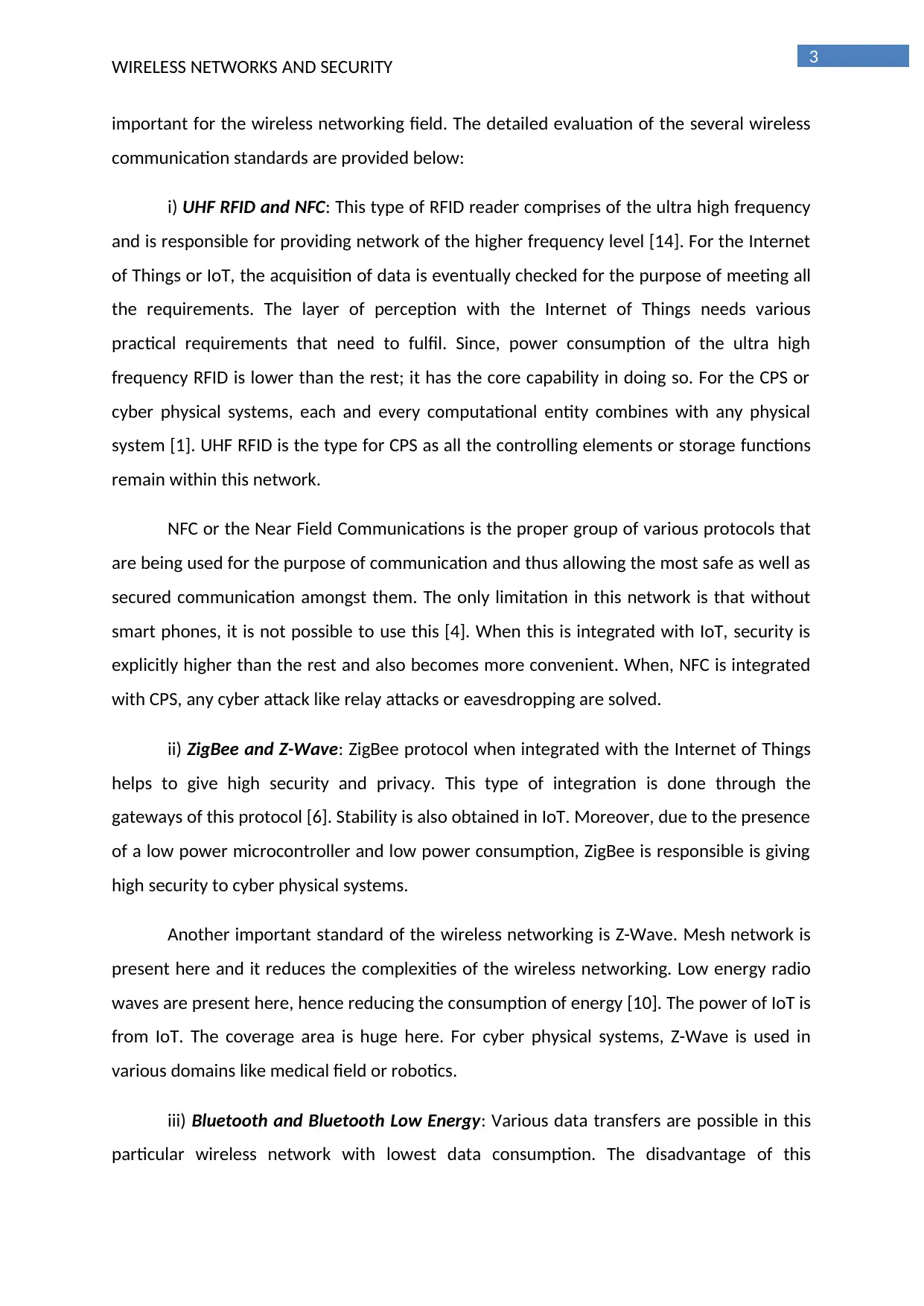
3
WIRELESS NETWORKS AND SECURITY
important for the wireless networking field. The detailed evaluation of the several wireless
communication standards are provided below:
i) UHF RFID and NFC: This type of RFID reader comprises of the ultra high frequency
and is responsible for providing network of the higher frequency level [14]. For the Internet
of Things or IoT, the acquisition of data is eventually checked for the purpose of meeting all
the requirements. The layer of perception with the Internet of Things needs various
practical requirements that need to fulfil. Since, power consumption of the ultra high
frequency RFID is lower than the rest; it has the core capability in doing so. For the CPS or
cyber physical systems, each and every computational entity combines with any physical
system [1]. UHF RFID is the type for CPS as all the controlling elements or storage functions
remain within this network.
NFC or the Near Field Communications is the proper group of various protocols that
are being used for the purpose of communication and thus allowing the most safe as well as
secured communication amongst them. The only limitation in this network is that without
smart phones, it is not possible to use this [4]. When this is integrated with IoT, security is
explicitly higher than the rest and also becomes more convenient. When, NFC is integrated
with CPS, any cyber attack like relay attacks or eavesdropping are solved.
ii) ZigBee and Z-Wave: ZigBee protocol when integrated with the Internet of Things
helps to give high security and privacy. This type of integration is done through the
gateways of this protocol [6]. Stability is also obtained in IoT. Moreover, due to the presence
of a low power microcontroller and low power consumption, ZigBee is responsible is giving
high security to cyber physical systems.
Another important standard of the wireless networking is Z-Wave. Mesh network is
present here and it reduces the complexities of the wireless networking. Low energy radio
waves are present here, hence reducing the consumption of energy [10]. The power of IoT is
from IoT. The coverage area is huge here. For cyber physical systems, Z-Wave is used in
various domains like medical field or robotics.
iii) Bluetooth and Bluetooth Low Energy: Various data transfers are possible in this
particular wireless network with lowest data consumption. The disadvantage of this
WIRELESS NETWORKS AND SECURITY
important for the wireless networking field. The detailed evaluation of the several wireless
communication standards are provided below:
i) UHF RFID and NFC: This type of RFID reader comprises of the ultra high frequency
and is responsible for providing network of the higher frequency level [14]. For the Internet
of Things or IoT, the acquisition of data is eventually checked for the purpose of meeting all
the requirements. The layer of perception with the Internet of Things needs various
practical requirements that need to fulfil. Since, power consumption of the ultra high
frequency RFID is lower than the rest; it has the core capability in doing so. For the CPS or
cyber physical systems, each and every computational entity combines with any physical
system [1]. UHF RFID is the type for CPS as all the controlling elements or storage functions
remain within this network.
NFC or the Near Field Communications is the proper group of various protocols that
are being used for the purpose of communication and thus allowing the most safe as well as
secured communication amongst them. The only limitation in this network is that without
smart phones, it is not possible to use this [4]. When this is integrated with IoT, security is
explicitly higher than the rest and also becomes more convenient. When, NFC is integrated
with CPS, any cyber attack like relay attacks or eavesdropping are solved.
ii) ZigBee and Z-Wave: ZigBee protocol when integrated with the Internet of Things
helps to give high security and privacy. This type of integration is done through the
gateways of this protocol [6]. Stability is also obtained in IoT. Moreover, due to the presence
of a low power microcontroller and low power consumption, ZigBee is responsible is giving
high security to cyber physical systems.
Another important standard of the wireless networking is Z-Wave. Mesh network is
present here and it reduces the complexities of the wireless networking. Low energy radio
waves are present here, hence reducing the consumption of energy [10]. The power of IoT is
from IoT. The coverage area is huge here. For cyber physical systems, Z-Wave is used in
various domains like medical field or robotics.
iii) Bluetooth and Bluetooth Low Energy: Various data transfers are possible in this
particular wireless network with lowest data consumption. The disadvantage of this
Secure Best Marks with AI Grader
Need help grading? Try our AI Grader for instant feedback on your assignments.
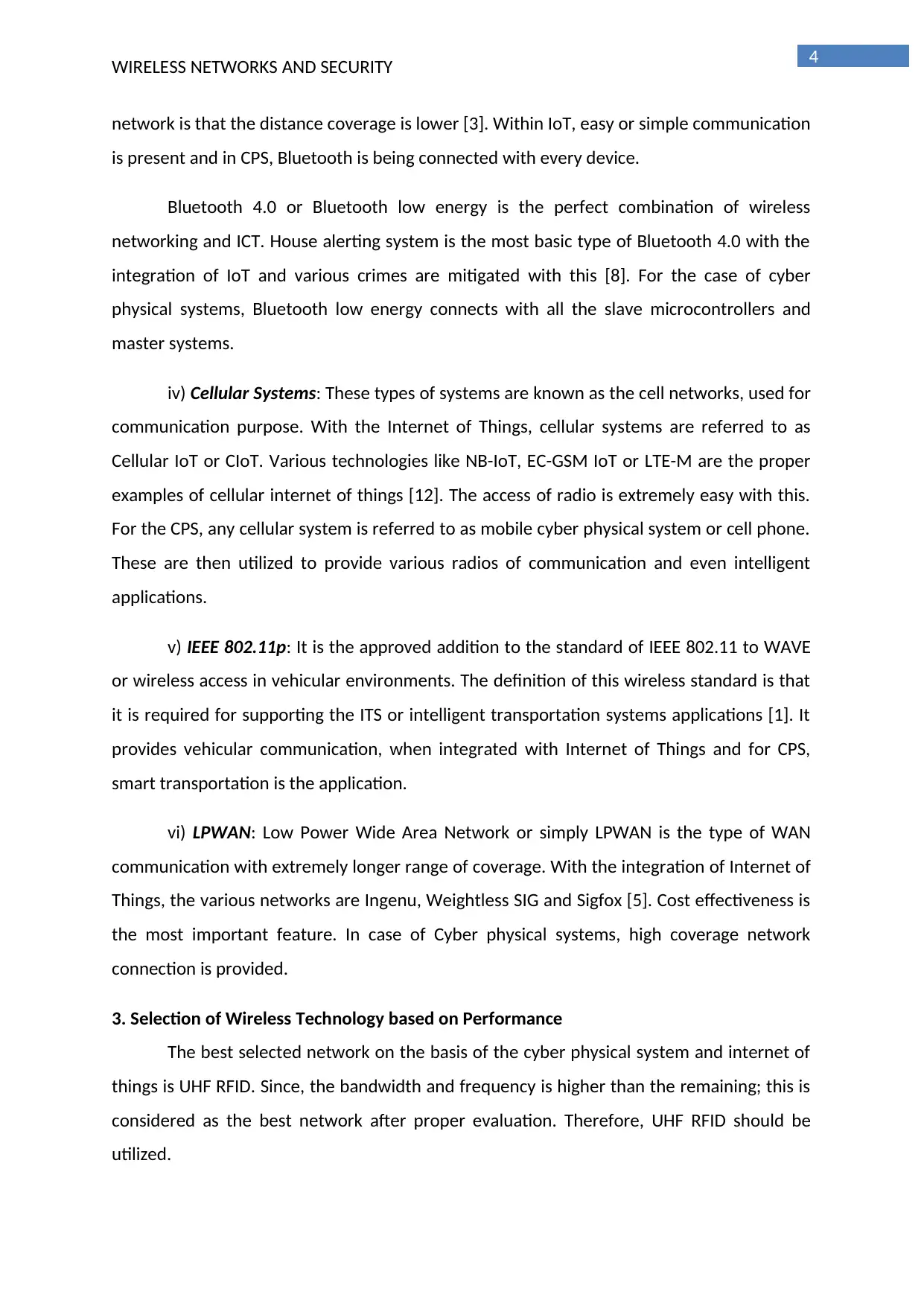
4
WIRELESS NETWORKS AND SECURITY
network is that the distance coverage is lower [3]. Within IoT, easy or simple communication
is present and in CPS, Bluetooth is being connected with every device.
Bluetooth 4.0 or Bluetooth low energy is the perfect combination of wireless
networking and ICT. House alerting system is the most basic type of Bluetooth 4.0 with the
integration of IoT and various crimes are mitigated with this [8]. For the case of cyber
physical systems, Bluetooth low energy connects with all the slave microcontrollers and
master systems.
iv) Cellular Systems: These types of systems are known as the cell networks, used for
communication purpose. With the Internet of Things, cellular systems are referred to as
Cellular IoT or CIoT. Various technologies like NB-IoT, EC-GSM IoT or LTE-M are the proper
examples of cellular internet of things [12]. The access of radio is extremely easy with this.
For the CPS, any cellular system is referred to as mobile cyber physical system or cell phone.
These are then utilized to provide various radios of communication and even intelligent
applications.
v) IEEE 802.11p: It is the approved addition to the standard of IEEE 802.11 to WAVE
or wireless access in vehicular environments. The definition of this wireless standard is that
it is required for supporting the ITS or intelligent transportation systems applications [1]. It
provides vehicular communication, when integrated with Internet of Things and for CPS,
smart transportation is the application.
vi) LPWAN: Low Power Wide Area Network or simply LPWAN is the type of WAN
communication with extremely longer range of coverage. With the integration of Internet of
Things, the various networks are Ingenu, Weightless SIG and Sigfox [5]. Cost effectiveness is
the most important feature. In case of Cyber physical systems, high coverage network
connection is provided.
3. Selection of Wireless Technology based on Performance
The best selected network on the basis of the cyber physical system and internet of
things is UHF RFID. Since, the bandwidth and frequency is higher than the remaining; this is
considered as the best network after proper evaluation. Therefore, UHF RFID should be
utilized.
WIRELESS NETWORKS AND SECURITY
network is that the distance coverage is lower [3]. Within IoT, easy or simple communication
is present and in CPS, Bluetooth is being connected with every device.
Bluetooth 4.0 or Bluetooth low energy is the perfect combination of wireless
networking and ICT. House alerting system is the most basic type of Bluetooth 4.0 with the
integration of IoT and various crimes are mitigated with this [8]. For the case of cyber
physical systems, Bluetooth low energy connects with all the slave microcontrollers and
master systems.
iv) Cellular Systems: These types of systems are known as the cell networks, used for
communication purpose. With the Internet of Things, cellular systems are referred to as
Cellular IoT or CIoT. Various technologies like NB-IoT, EC-GSM IoT or LTE-M are the proper
examples of cellular internet of things [12]. The access of radio is extremely easy with this.
For the CPS, any cellular system is referred to as mobile cyber physical system or cell phone.
These are then utilized to provide various radios of communication and even intelligent
applications.
v) IEEE 802.11p: It is the approved addition to the standard of IEEE 802.11 to WAVE
or wireless access in vehicular environments. The definition of this wireless standard is that
it is required for supporting the ITS or intelligent transportation systems applications [1]. It
provides vehicular communication, when integrated with Internet of Things and for CPS,
smart transportation is the application.
vi) LPWAN: Low Power Wide Area Network or simply LPWAN is the type of WAN
communication with extremely longer range of coverage. With the integration of Internet of
Things, the various networks are Ingenu, Weightless SIG and Sigfox [5]. Cost effectiveness is
the most important feature. In case of Cyber physical systems, high coverage network
connection is provided.
3. Selection of Wireless Technology based on Performance
The best selected network on the basis of the cyber physical system and internet of
things is UHF RFID. Since, the bandwidth and frequency is higher than the remaining; this is
considered as the best network after proper evaluation. Therefore, UHF RFID should be
utilized.
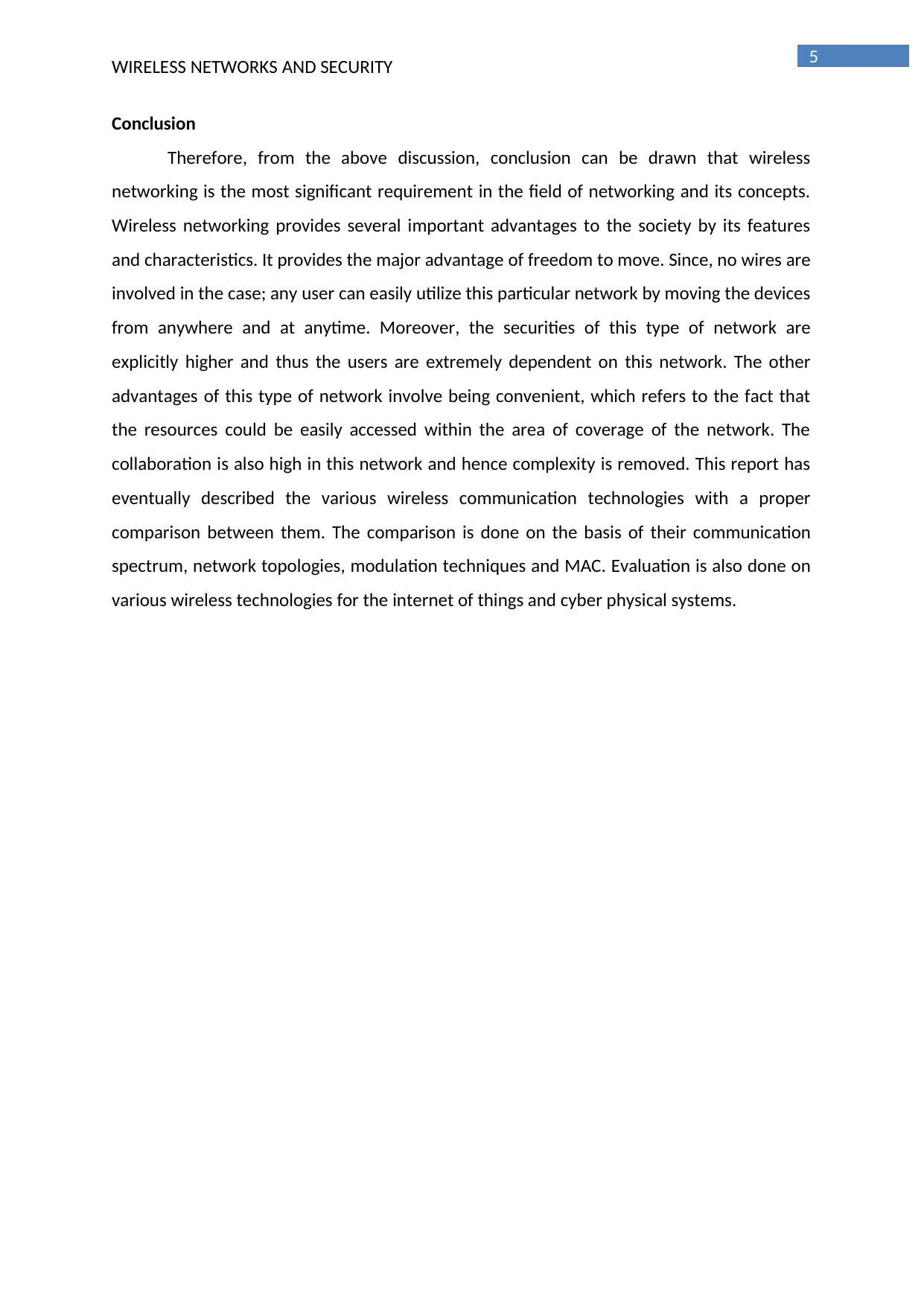
5
WIRELESS NETWORKS AND SECURITY
Conclusion
Therefore, from the above discussion, conclusion can be drawn that wireless
networking is the most significant requirement in the field of networking and its concepts.
Wireless networking provides several important advantages to the society by its features
and characteristics. It provides the major advantage of freedom to move. Since, no wires are
involved in the case; any user can easily utilize this particular network by moving the devices
from anywhere and at anytime. Moreover, the securities of this type of network are
explicitly higher and thus the users are extremely dependent on this network. The other
advantages of this type of network involve being convenient, which refers to the fact that
the resources could be easily accessed within the area of coverage of the network. The
collaboration is also high in this network and hence complexity is removed. This report has
eventually described the various wireless communication technologies with a proper
comparison between them. The comparison is done on the basis of their communication
spectrum, network topologies, modulation techniques and MAC. Evaluation is also done on
various wireless technologies for the internet of things and cyber physical systems.
WIRELESS NETWORKS AND SECURITY
Conclusion
Therefore, from the above discussion, conclusion can be drawn that wireless
networking is the most significant requirement in the field of networking and its concepts.
Wireless networking provides several important advantages to the society by its features
and characteristics. It provides the major advantage of freedom to move. Since, no wires are
involved in the case; any user can easily utilize this particular network by moving the devices
from anywhere and at anytime. Moreover, the securities of this type of network are
explicitly higher and thus the users are extremely dependent on this network. The other
advantages of this type of network involve being convenient, which refers to the fact that
the resources could be easily accessed within the area of coverage of the network. The
collaboration is also high in this network and hence complexity is removed. This report has
eventually described the various wireless communication technologies with a proper
comparison between them. The comparison is done on the basis of their communication
spectrum, network topologies, modulation techniques and MAC. Evaluation is also done on
various wireless technologies for the internet of things and cyber physical systems.
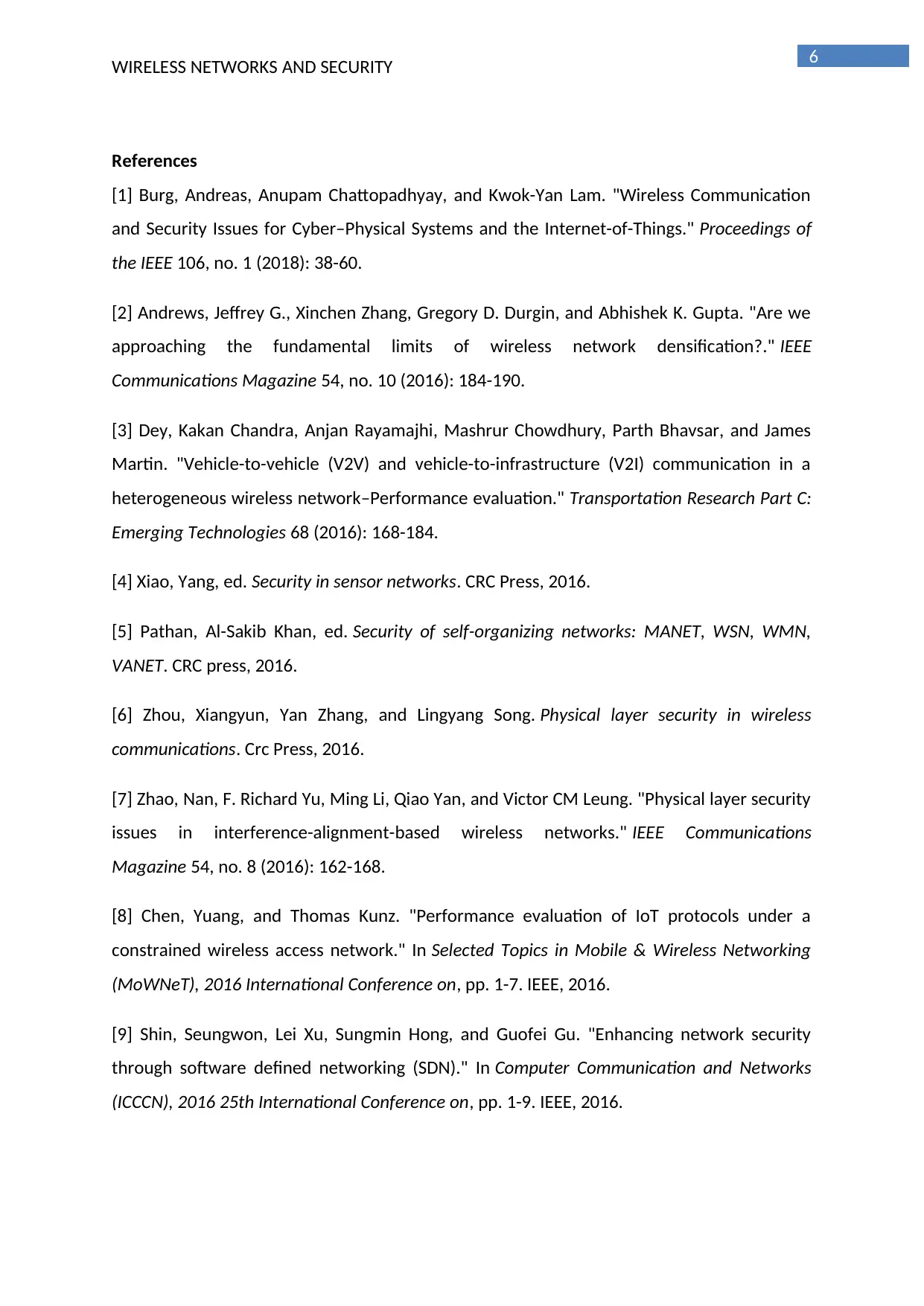
6
WIRELESS NETWORKS AND SECURITY
References
[1] Burg, Andreas, Anupam Chattopadhyay, and Kwok-Yan Lam. "Wireless Communication
and Security Issues for Cyber–Physical Systems and the Internet-of-Things." Proceedings of
the IEEE 106, no. 1 (2018): 38-60.
[2] Andrews, Jeffrey G., Xinchen Zhang, Gregory D. Durgin, and Abhishek K. Gupta. "Are we
approaching the fundamental limits of wireless network densification?." IEEE
Communications Magazine 54, no. 10 (2016): 184-190.
[3] Dey, Kakan Chandra, Anjan Rayamajhi, Mashrur Chowdhury, Parth Bhavsar, and James
Martin. "Vehicle-to-vehicle (V2V) and vehicle-to-infrastructure (V2I) communication in a
heterogeneous wireless network–Performance evaluation." Transportation Research Part C:
Emerging Technologies 68 (2016): 168-184.
[4] Xiao, Yang, ed. Security in sensor networks. CRC Press, 2016.
[5] Pathan, Al-Sakib Khan, ed. Security of self-organizing networks: MANET, WSN, WMN,
VANET. CRC press, 2016.
[6] Zhou, Xiangyun, Yan Zhang, and Lingyang Song. Physical layer security in wireless
communications. Crc Press, 2016.
[7] Zhao, Nan, F. Richard Yu, Ming Li, Qiao Yan, and Victor CM Leung. "Physical layer security
issues in interference-alignment-based wireless networks." IEEE Communications
Magazine 54, no. 8 (2016): 162-168.
[8] Chen, Yuang, and Thomas Kunz. "Performance evaluation of IoT protocols under a
constrained wireless access network." In Selected Topics in Mobile & Wireless Networking
(MoWNeT), 2016 International Conference on, pp. 1-7. IEEE, 2016.
[9] Shin, Seungwon, Lei Xu, Sungmin Hong, and Guofei Gu. "Enhancing network security
through software defined networking (SDN)." In Computer Communication and Networks
(ICCCN), 2016 25th International Conference on, pp. 1-9. IEEE, 2016.
WIRELESS NETWORKS AND SECURITY
References
[1] Burg, Andreas, Anupam Chattopadhyay, and Kwok-Yan Lam. "Wireless Communication
and Security Issues for Cyber–Physical Systems and the Internet-of-Things." Proceedings of
the IEEE 106, no. 1 (2018): 38-60.
[2] Andrews, Jeffrey G., Xinchen Zhang, Gregory D. Durgin, and Abhishek K. Gupta. "Are we
approaching the fundamental limits of wireless network densification?." IEEE
Communications Magazine 54, no. 10 (2016): 184-190.
[3] Dey, Kakan Chandra, Anjan Rayamajhi, Mashrur Chowdhury, Parth Bhavsar, and James
Martin. "Vehicle-to-vehicle (V2V) and vehicle-to-infrastructure (V2I) communication in a
heterogeneous wireless network–Performance evaluation." Transportation Research Part C:
Emerging Technologies 68 (2016): 168-184.
[4] Xiao, Yang, ed. Security in sensor networks. CRC Press, 2016.
[5] Pathan, Al-Sakib Khan, ed. Security of self-organizing networks: MANET, WSN, WMN,
VANET. CRC press, 2016.
[6] Zhou, Xiangyun, Yan Zhang, and Lingyang Song. Physical layer security in wireless
communications. Crc Press, 2016.
[7] Zhao, Nan, F. Richard Yu, Ming Li, Qiao Yan, and Victor CM Leung. "Physical layer security
issues in interference-alignment-based wireless networks." IEEE Communications
Magazine 54, no. 8 (2016): 162-168.
[8] Chen, Yuang, and Thomas Kunz. "Performance evaluation of IoT protocols under a
constrained wireless access network." In Selected Topics in Mobile & Wireless Networking
(MoWNeT), 2016 International Conference on, pp. 1-7. IEEE, 2016.
[9] Shin, Seungwon, Lei Xu, Sungmin Hong, and Guofei Gu. "Enhancing network security
through software defined networking (SDN)." In Computer Communication and Networks
(ICCCN), 2016 25th International Conference on, pp. 1-9. IEEE, 2016.
Paraphrase This Document
Need a fresh take? Get an instant paraphrase of this document with our AI Paraphraser
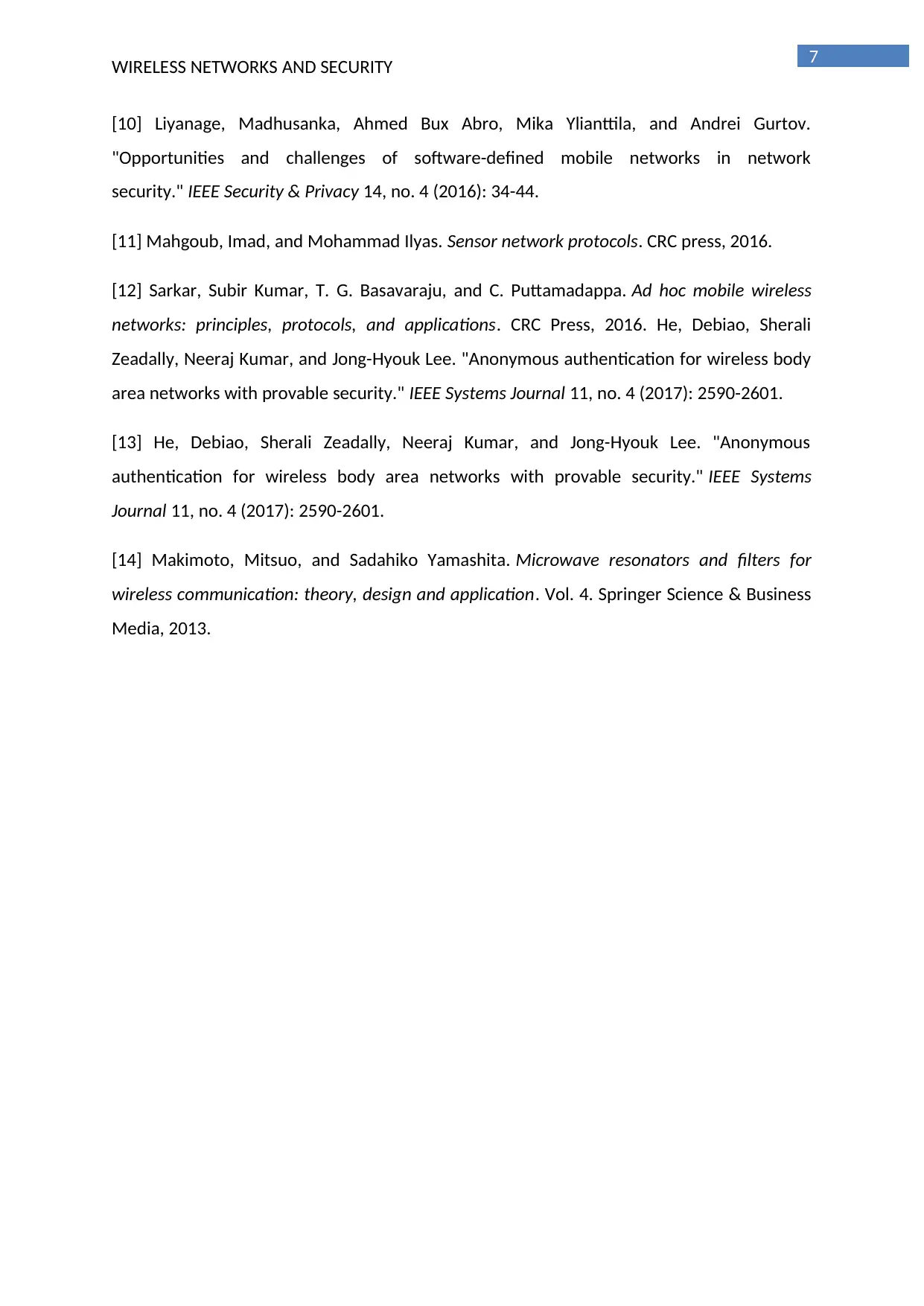
7
WIRELESS NETWORKS AND SECURITY
[10] Liyanage, Madhusanka, Ahmed Bux Abro, Mika Ylianttila, and Andrei Gurtov.
"Opportunities and challenges of software-defined mobile networks in network
security." IEEE Security & Privacy 14, no. 4 (2016): 34-44.
[11] Mahgoub, Imad, and Mohammad Ilyas. Sensor network protocols. CRC press, 2016.
[12] Sarkar, Subir Kumar, T. G. Basavaraju, and C. Puttamadappa. Ad hoc mobile wireless
networks: principles, protocols, and applications. CRC Press, 2016. He, Debiao, Sherali
Zeadally, Neeraj Kumar, and Jong-Hyouk Lee. "Anonymous authentication for wireless body
area networks with provable security." IEEE Systems Journal 11, no. 4 (2017): 2590-2601.
[13] He, Debiao, Sherali Zeadally, Neeraj Kumar, and Jong-Hyouk Lee. "Anonymous
authentication for wireless body area networks with provable security." IEEE Systems
Journal 11, no. 4 (2017): 2590-2601.
[14] Makimoto, Mitsuo, and Sadahiko Yamashita. Microwave resonators and filters for
wireless communication: theory, design and application. Vol. 4. Springer Science & Business
Media, 2013.
WIRELESS NETWORKS AND SECURITY
[10] Liyanage, Madhusanka, Ahmed Bux Abro, Mika Ylianttila, and Andrei Gurtov.
"Opportunities and challenges of software-defined mobile networks in network
security." IEEE Security & Privacy 14, no. 4 (2016): 34-44.
[11] Mahgoub, Imad, and Mohammad Ilyas. Sensor network protocols. CRC press, 2016.
[12] Sarkar, Subir Kumar, T. G. Basavaraju, and C. Puttamadappa. Ad hoc mobile wireless
networks: principles, protocols, and applications. CRC Press, 2016. He, Debiao, Sherali
Zeadally, Neeraj Kumar, and Jong-Hyouk Lee. "Anonymous authentication for wireless body
area networks with provable security." IEEE Systems Journal 11, no. 4 (2017): 2590-2601.
[13] He, Debiao, Sherali Zeadally, Neeraj Kumar, and Jong-Hyouk Lee. "Anonymous
authentication for wireless body area networks with provable security." IEEE Systems
Journal 11, no. 4 (2017): 2590-2601.
[14] Makimoto, Mitsuo, and Sadahiko Yamashita. Microwave resonators and filters for
wireless communication: theory, design and application. Vol. 4. Springer Science & Business
Media, 2013.
1 out of 8
Related Documents
Your All-in-One AI-Powered Toolkit for Academic Success.
+13062052269
info@desklib.com
Available 24*7 on WhatsApp / Email
![[object Object]](/_next/static/media/star-bottom.7253800d.svg)
Unlock your academic potential
© 2024 | Zucol Services PVT LTD | All rights reserved.



